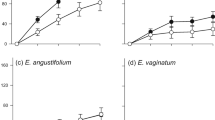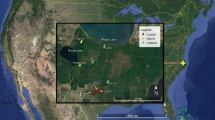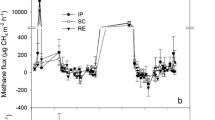Abstract
Plants can influence methane emissions from wetland ecosystems by altering its production, consumption and transport in the soil. The aim of this study was to investigate how eight vascular plant species from mesotrophic to eutrophic wetlands vary in their influence on CH4 emissions from peat cores, under low and high N supply. Additionally, we measured the production of low-molecular-weight organic acids (LOA) by the same species (also at low and high N supply), because LOA form a substrate for methanogenesis. There were considerable differences among species in their effects upon rates of CH4 emission. Six of the species (Eriophorum latifolium Hoppe, Potentilla palustris (L.) Scop., Anthoxanthum odoratum (L.) s. str., Carex rostrata Stokes, Carex elata All., Carex acutiformis Ehrh.) increased CH4 emissions up to five times compared to control peat cores without plants, whereas two species (Phalaris arundinacea L., Phragmites australis (Cav.) Trin. ex Steud.) had no effect. There was a weak negative correlation between plant biomass and CH4 emission. N addition had no significant general effect upon CH4 emission. LOA production varied considerably among species, and tended to be highest for species from mesotrophic habitats. LOA production was stimulated by N addition. We conclude that some species from mesotrophic wetlands tend to cause higher CH4 emissions than species from eutrophic wetlands. This pattern, which contradicts what is often mentioned in literature, may be explained by the higher LOA production rates of species adapted to less productive habitats.





Similar content being viewed by others
References
Bais HP, Weir TL, Perry LG, Gilroy S, Vivanco JM (2006) The role of root exudates in rhizosphere interations with plants and other organisms. Annu Rev Plant Biol 57:233–266. doi:10.1146/annurev.arplant.57.032905.105159
Bakkenes MD, Zwart de D, Alkemade JRM (2002) MOVE nationaal Model voor de Vegetatie versie 3.2 Achtergronden en analyse van modelvarianten. IVM, Bilthoven - Nederland
Bedford BL, Walbridge MR, Aldous A (1999) Patterns of nutrient availability and plant diversity of temperate North American wetlands. Ecology 80:2151–2169
Bouchard V, Frey SD, Gilbert JM, Reed SE (2007) Effects of macrophyte functional group richness on emergent freshwater wetland functions. Ecology 88:2903–2914. doi:10.1890/06-1144.1
Bragazza L, Freeman C, Jones T, Rydin H, Limpens J, Fenner N, Ellis T, Gerdol R, Hajek M, Lacumin P, Kutnar L, Tahvanainen T, Toberman H (2006) Atmospheric nitrogen deposition promotes carbon loss from peat bogs. Proc Natl Acad Sci USA 103:19386–19389. doi:10.1073/pnas.0606629104
Burnham KP, Anderson DR (2002) Model selection and multimodel inference. Springer, Berlin
BUWAL (2005). Stickstoffhaltige Luftschadstoffe in der Schweiz. Status-Bericht der Eidg. Kommission für Lufthygiene. Schriftenreihe Umwelt Nr. 384. Bundesamt für Umwelt,Wald und Landschaft, BUWAL, Bern. (http://www.bafu.admin.ch/luft/00612/00624/)
Chanton JP, Bauer JE, Glaser PA, Siegel DI, Kelley CA, Tyler SC, Romanowicz EH, Lazrus A (1995) Radiocarbon Evidence for the Substrates Supporting Methane Formation within Northern Minnesota Peatlands. Geochim Cosmochim Acta 59:3663–3668. doi:10.1016/0016-7037(95)00240-Z
Chanton JP, Whiting GJ, Blair NE, Lindau CW, Bollich PK (1997) Methane emission from rice: Stable isotopes, diurnal variations, and CO2 exchange. Global Biogeochem Cycles 11:15–27. doi:10.1029/96GB03761
Christensen TR, Panikov N, Mastepanov M, Joabsson A, Stewart A, Oquist M, Sommerkorn M, Reynaud S, Svensson B (2003) Biotic controls on CO2 and CH4 exchange in wetlands - a closed environment study. Biogeochemistry 64:337–354. doi:10.1023/A:1024913730848
Christensen TR, Johansson TR, Malmer N, Åkerman JH, Friborg T, Crill P, Mastepanov M, Svensson BH (2004) Thawing sub-arctic permafrost: Effects on vegetation and methane emissions. Geophys Res Lett 31:L04501. doi:10.1029/2003GL018680
Dacey JWH, Drake BG, Klug MJ (1994) Stimulation of Methane Emission by Carbon-Dioxide Enrichment of Marsh Vegetation. Nature 370:47–49. doi:10.1038/370047a0
Dakora FD, Phillips DA (2002) Root exudates as mediators of mineral acquisition in low-nutrient environments. Plant Soil 245:35–47. doi:10.1023/A:1020809400075
Dessureault-Rompré J, Nowack B, Schulin R, Luster J (2007) Spatial and temporal variation in organic acid anion exudation and nutrient anion uptake in the rhizosphere of Lupinus albus L. Plant Soil 301:123–134. doi:10.1007/s11104-007-9427-x
Ding WX, Cai ZC, Tsuruta H, Li XP (2003) Key factors affecting spatial variation of methane emissions from freshwater marshes. Chemosphere 51:167–173. doi:10.1016/S0045-6535(02)00804-4
Ding WX, Cai ZC, Tsuruta H (2005) Plant species effects on methane emissions from freshwater marshes. Atmos Environ 39:3199–3207. doi:10.1016/j.atmosenv.2005.02.022
Ellenberg H, Weber HE, Düll R, Wirth V, Werner W, Paulißen D (1991) Zeigerwerte von Pflanzen in Mitteleuropa. Scr Geobot 18:1–248
Galloway JN, Dentener FJ, Capone DG, Boyer EW, Howarth RW, Seitzinger SP, Asner GP, Cleveland CC, Green PA, Holland EA, Karl DM, Michaels AF, Porter JH, Townsend AR, Vörösmarty CJ (2004) Nitrogen cycles: past, present, and future. Biogeochemistry 70:153–226. doi:10.1007/s10533-004-0370-0
Greenup AL, Bradford MA, McNamara NP, Ineson P, Lee JA (2000) The role of Eriophorum vaginatum in CH4 flux from an ombrotrophic peatland. Plant Soil 227:265–272. doi:10.1023/A:1026573727311
Henry F, Nguyen C, Paterson E, Sim A, Robin C (2005) How does nitrogen availability alter rhizodeposition in Lolium multiflorum Lam. during vegetative growth? Plant Soil 269:181–191. doi:10.1007/s11104-004-0490-2
Hinsinger P (2001) Bioavailability of soil inorganic P in the rhizosphere as affected by root-induced chemical changes: a review. Plant Soil 237:173–195. doi:10.1023/A:1013351617532
Hirota M, Tang YH, Hu QW, Hirata S, Kato T, Mo WH, Cao GM, Mariko S (2004) Methane emissions from different vegetation zones in a Qinghai-Tibetan Plateau wetland. Soil Biol Biochem 36:737–748. doi:10.1016/j.soilbio.2003.12.009
IPCC 2007 Climate Change (2007) The Physical Science Basis. Contribution of Working Group I to the Fourth Assessment Report of the Intergovernmental Panel on Climate Change. Cambridge University Press, Cambridge
Joabsson A, Christensen TR (2001) Methane emissions from wetlands and their relationship with vascular plants: an Arctic example. Glob Change Biol 7:919–932. doi:10.1046/j.1354-1013.2001.00044.x
Joabsson A, Christensen TR, Wallen B (1999) Vascular plant controls on methane emissions from northern peatforming wetlands. Trends Ecol Evol 14:385–388. doi:10.1016/S0169-5347(99)01649-3
Johansson T, Malmer N, Crill PM, Friborg T, Åkerman JH, Mastepanov M, Christensen TR (2006) Decadal vegetation changes in a northern peatland, greenhouse gas fluxes and net radiative forcing. Glob Change Biol 12:2352–2369. doi:10.1111/j.1365-2486.2006.01267.x
Jones DL (1998) Organic acids in the rhizosphere - a critical review. Plant Soil 205:25–44. doi:10.1023/A:1004356007312
Jones DL, Hodge A, Kuzyakov Y (2004) Plant and mycorrhizal regulation of rhizodeposition. New Phytol 163:459–480. doi:10.1111/j.1469-8137.2004.01130.x
Kankaala P, Ojala A, Kaki T (2004) Temporal and spatial variation in methane emissions from a flooded transgression shore of a boreal lake. Biogeochemistry 68:297–311. doi:10.1023/B:BIOG.0000031030.77498.1f
Laine A, Wilson D, Kiely G, Byrne KA (2007) Methane flux dynamics in an Irish lowland blanket bog. Plant Soil 299:181–193. doi:10.1007/s11104-007-9374-6
Le Mer J, Roger P (2001) Production, oxidation, emission and consumption of methane by soils: A review. Eur J Soil Biol 37:25–50. doi:10.1016/S1164-5563(01)01067-6
Lu Y, Wassmann R, Neue HU, Huang C (1999) Impact of phosphorus supply on root exudation, aerenchyma formation and methane emission of rice plants. Biogeochemistry 47:203–218
Marschner H (1998) Role of root growth, arbuscular mycorrhiza, and root exudates for the efficiency in nutrient acquisition. Field Crops Res 56:203–207. doi:10.1016/S0378-4290(97)00131-7
Neumann G, Römheld V (1999) Root excretion of carboxylic acids and protons in phosphorus-deficient plants. Plant Soil 211:121–130. doi:10.1023/A:1004380832118
Olde Venterink H, Pieterse NM, Belgers JDM, Wassen MJ, De Ruiter PC (2002) N, P and K budgets along nutrient availability and productivity gradients in wetlands. Ecol Appl 12:1010–1026. doi:10.1890/1051-0761(2002)012[1010:NPAKBA]2.0.CO;2
R Development Core Team (2006) R: A Language and Environment for Statistical Computing. R Foundation for Statistical Computing, Vienna, Austria. http://www.r-project.org/
Saarnio S, Wittenmayer L, Merbach W (2004) Rhizospheric exudation of Eriophorum vaginatum L. - Potential link to methanogenesis. Plant Soil 267:343–355. doi:10.1007/s11104-005-0140-3
Silvola J, Saarnio S, Foot J, Sundh I, Greenup A, Heijmans M, Ekberg A, Mitchell E, van Breemen N (2003) Effects of elevated CO2 and N deposition on CH4 emissions from European mires. Glo Biogeochem Cy 17:1068. doi:10.1029/2002GB001886
Steiner AA (1961) A universal method for preparing nutrient solutions of a certain desired composition. Plant Soil 15:134–154. doi:10.1007/BF01347224
Ström L (1997) Root exudation of organic acids: importance to nutrient availability and the calcifuge and calcicole behaviour of plants. Oikos 80:459–466. doi:10.2307/3546618
Ström L, Ekberg A, Mastepanov M, Christensen TR (2003) The effect of vascular plants on carbon turnover and methane emissions from a tundra wetland. Glob Change Biol 9:1185–1192. doi:10.1046/j.1365-2486.2003.00655.x
Ström L, Mastepanov M, Christensen TR (2005) Species-specific effects of vascular plants on carbon turnover and methane emissions from wetlands. Biogeochemistry 75:65–82. doi:10.1007/s10533-004-6124-1
Van der Nat F, Middelburg JJ (1998) Seasonal variation in methane oxidation by the rhizosphere of Phragmites australis and Scirpus lacustris. Aquat Bot 61:95–110. doi:10.1016/S0304-3770(98)00072-2
Verville JH, Hobbie SE, Chapin FS, Hooper DU (1998) Response of tundra CH4 and CO2 flux to manipulation of temperature and vegetation. Biogeochemistry 41:215–235. doi:10.1023/A:1005984701775
Waddington JM, Roulet NT, Swanson RV (1996) Water table control of CH4 emission enhancement by vascular plants in boreal peatlands. J Geophys Res 101:22775–22785. doi:10.1029/96JD02014 Atmos
Whiting GJ, Chanton JP (1992) Plant-dependent CH4 emission in a subarctic canadian fen. Global Biogeochem Cycles 6:225–231. doi:10.1029/92GB00710
Whiting GJ, Chanton JP (1993) Primary Production Control of Methane Emission from Wetlands. Nature 364:794–795. doi:10.1038/364794a0
Wilson D, Alm J, Laine J, Byrne KA, Farrell EP, Tuittila ES (2008) Rewetting of Cutaway Peatlands: Are We Re-Creating Hot Spots of Methane Emissions? Restor Ecol. doi:10.1111/j.1526-100X.2008.00416.x
Zar JH (1999) Biostatistical analysis. Prentice Hall, Upper Saddle River, New Jersey
Acknowledgements
We thank Adrian Hartmann and Jacynthe Dessureault-Rompré for their help with the measurements of CH4 and organic acids respectively, and Martin Schroth for providing the possibility to use the ion chromatograph. Carmen Rothenbühler, Pascal Niklaus and René Graf for practical and interspecific technical help during the experiments. Financial support within the project TUMSS (Towards the Understanding of Methane Sinks and Sources) funded by ETH's School Domain of Earth, Environment and Natural Resources is gratefully acknowledged.
Author information
Authors and Affiliations
Corresponding author
Additional information
Responsible Editor: Per Ambus.
Appendices
Appendix A
The eight plant species used in the experiments with their Ellenberg- and MOVE N indicator values (Bakkenes et al. 2002; Ellenberg et al. 1991). MOVE values are based on Ellenberg values. A dataset of 100’000 vegetation relevees from the Netherlands served as a base for the calculation of these values.
Species | Ellenberg N-value | MOVE N-value |
Eriophorum latifolium | 2 | – |
Potentilla palustris | 2 | 4.07 (±0.96) |
Carex rostrata | 3 | 4.02 (±1.17) |
Anthoxanthum odoratum | – | 4.47 (±1.06) |
Carex elata | 5 | 4.93 (±1.00) |
Carex acutiformis | 5 | 5.14 (±0.97) |
Phragmites australis | 7 | 5.52 (±1.22) |
Phalaris arundinacea | 7 | 6.14 (±0.72) |
Appendix B
Mean total acetate (A) and formate (B) production (+/− SE) per plant of eight wetland species in nutrient solution during three days. Species are ordered according to the fertility index (N-values) of Ellenberg et al. (1991) increasing from left to right (see Appendix A). Notice the different scales in A and B.

Rights and permissions
About this article
Cite this article
Koelbener, A., Ström, L., Edwards, P.J. et al. Plant species from mesotrophic wetlands cause relatively high methane emissions from peat soil. Plant Soil 326, 147–158 (2010). https://doi.org/10.1007/s11104-009-9989-x
Received:
Accepted:
Published:
Issue Date:
DOI: https://doi.org/10.1007/s11104-009-9989-x




